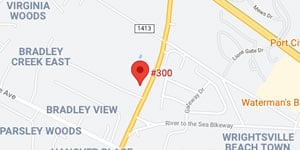
Intro to Pedestrian Safety in North Carolina
Across the U.S. in 2015, roughly 5,376 pedestrians were killed and over 70,000 injured in accidents involving motor vehicles on public roads. Emergency room data shows that a large percentage of pedestrian accidents occur on private roads, indicating that the 70,000 injuries is likely much less than the actual total.
In North Carolina, data show that over 3,000 pedestrians and 800 bicyclists are involved in collisions with vehicles each year. Pedestrian fatalities comprise almost 15% of overall traffic fatalities. Alcohol is often a factor in pedestrian accidents.
How Pedestrian Accidents Occur
Pedestrians tend to be struck by the front ends of motor vehicles. Standard passenger cars tend to strike pedestrians in the lower-middle section of their bodies; SUVs or pickup trucks strike in the upper-middle section. Young children are particularly susceptible to severe injury in these collisions. When taller vehicles are involved, the pedestrian is more likely to land on the ground in front of the vehicle after impact.
There is a strong correlation between the severity of an accident and the rate of speed that the vehicle is traveling at the time.
North Carolina Pedestrian Laws
At all times, drivers must use care to avoid potential collisions with pedestrians and should use their horns as needed to warn of their presence. Drivers should use special caution when a child or disabled person is present.
Here are the rules for pedestrians:
- Pedestrians at Traffic Signals: North Carolina statute makes pedestrians subject to signals for controlling traffic. The WALK signal gives the pedestrian right-of-way to proceed across the roadway. Pedestrians are not to start crossing the roadway when the DON’T WALK signal is in place. Pedestrians may not willfully obstruct or inhibit the flow of roadway traffic.
- Pedestrians at Crosswalks: When pedestrian traffic signals are not present or inoperable, drivers are to yield the right-of-way to pedestrians within either a marked or unmarked crosswalk. When a vehicle is stopped at a marked or unmarked crosswalk to allow a pedestrian to cross, drivers traveling behind that vehicle are prohibited from passing. Drivers who are exiting alleys, driveways, or private drives are to yield to pedestrians using the sidewalk.
- Pedestrians Crossing Outside of Crosswalk: When pedestrians are attempting to cross a road at a point without a marked or unmarked crosswalk, they must yield to vehicles. When intersections with traffic signals are present, pedestrians may only cross there using the crosswalk. Pedestrians may not walk along the road when sidewalks are provided.
Electric and Hybrid Vehicle Danger
Pedestrians generally will detect the sound of an emerging vehicle if they do not see it. Electric vehicles or hybrid vehicles in electric mode present a unique concern based on their relatively quiet operation. These vehicles are 39% more likely to be involved in a pedestrian-related crash, especially when backing up or making a turn. In response, the U.S. Department of Transportation now requires these vehicles to be manufactured with the capability of generating some type of sound for pedestrian safety.
North Carolina Safety Initiative
The North Carolina Department of Transportation established a Division of Bicycle and Pedestrian Transportation in 1973. Their programs are designed to improve bicycle and pedestrian safety, as well as increase accessibility within the scope of the transportation network. The “Watch for Me NC” initiative was created to reduce the number of accidents involving pedestrians and bicyclists. The initiative combines efforts in public education, community awareness, and cooperation with local law enforcement. The local Wilmington “Watch for Me NC” has led the way in improving safety in areas of higher traffic throughout New Hanover County. A recent partnership was created with UNC-Wilmington and Cape Fear Community College to promote safety and improve conditions.
Pedestrian Safety Tips
Pedestrians should never assume that a driver sees them and should always exercise caution. Here are some safety tips:
- When crossing a multi-lane road, cross one lane at a time.
- When walking at night, try to wear bright or reflective clothing to enhance your visibility.
- Limit distractions such as using mobile devices while walking.
- Watch for vehicles backing out when in parking areas—the rear brake lights are the best indicator.
- If there is no sidewalk, walk to the side of the roadway facing traffic.
- When crossing a street, try to do so from a position that allows for the best possible view of traffic.
- Around bus stops, it is best to cross the road from behind the bus, or at a marked crosswalk when available.
- Remember to limit your consumption of alcohol when you will be walking.
If you were practicing “safe walking” but still were hit by a motorist, you may be able to claim compensation from the at-fault driver. For a consultation with an experienced North Carolina pedestrian accident attorney about your rights and options, please call Rhine Law Firm, P.C., at (910) 772-9960.
About Us
Rhine Law Firm, P.C. serves clients throughout North Carolina and nationwide, specializing in complex civil litigation led by Joel Rhine. With expertise in personal injury, car accidents, property damage, sex abuse, and more, the firm is passionate about taking on challenging cases. They emphasize providing personalized legal representation, prioritizing their clients’ best interests while offering state-of-the-art legal strategies. Rhine Law Firm’s dedicated attorneys enjoy the fight for justice and are committed to guiding clients through complicated legal processes. The firm offers free consultations, flexible appointment scheduling, and Spanish language services.




